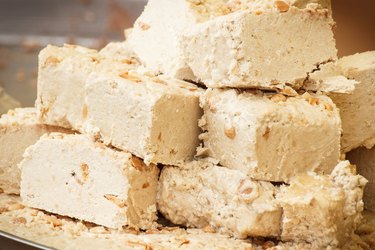
Halva, a traditional sweet found in the Middle East, Greece and Israel, is typically made with a mix of either honey and sesame seeds or sesame seed paste and sugar. Although the sesame seeds provide some essential minerals, halva is a candy, so it isn't particularly healthy due to its high sugar content. Halva has also been linked to outbreaks of salmonella.
Tip
While halva contains some nutritious items, it's a candy that's high in sugar and may not make the healthiest choice. But can serve as a sweet treat on a healthy, balanced diet.
Video of the Day
Halva Macronutrient Content
A 1-ounce serving of halva has about 131 calories, 3.5 grams of protein, 17 grams of carbohydrates and 6 grams of fat, or about 9 percent of the daily value for fat. Only 1.2 grams of this fat is the unhealthy saturated type, however, with the rest coming from healthier unsaturated fats. Halva also provides a small amount of fiber, with 1.3 grams, or about 5 percent of the DV.
Video of the Day
Halva Micronutrient Content
While halva isn't a particularly good source of vitamins, it does provide significant amounts of a number of minerals. Each 1-ounce serving has 17 percent of the DV for copper and phosphorus, 15 percent of the DV for magnesium and 12 percent of the DV for manganese. You need copper for forming red blood cells, phosphorus and magnesium for forming DNA and manganese for healing wounds.
Halva Sugar Considerations
Sugar in some form is one of the two main ingredients of halva. Added sugars increase the number of calories in your diet without providing any essential nutrients. This is why these calories are often called "empty" calories. High-sugar foods can crowd out other more nutritious foods and increase your risk for obesity and obesity-related health conditions. This doesn't mean you can't eat halva, just that you should enjoy it only occasionally and in moderation.
Food Safety
Salmonella, a food-borne illness that causes fever, abdominal cramps and diarrhea, affects approximately 1.2 million people in the U.S. each year, according to the Centers for Disease Control and Prevention. Although salmonella infections are most often caused by contaminated poultry, eggs or fresh produce, other foods, such as halva, can also become contaminated with these bacteria. The low-moisture environment provided by halva limits the growth of salmonella, but being stored at room temperature instead of refrigerated and being vacuum-packed instead of air-sealed can increase the risk that any salmonella in the food may survive, according to an article published in "Frontiers in Microbiology" in 2013.
- Health-Alicious-Ness.com: Nutrition Facts Comparison Tool
- AARP: Basic Halva Recipe
- American Heart Association: Sugars 101
- International Food Safety Authorities Network: Unusual Sources of Salmonella
- Frontiers in Microbiology: Mechanisms of Survival, Responses and Sources of Salmonella in Low-Moisture Environments
- Centers for Disease Control and Prevention: Salmonella